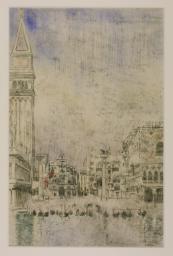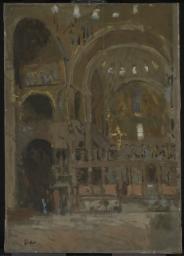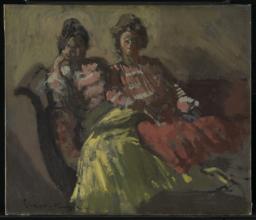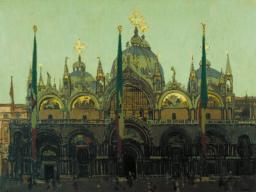Walter Richard Sickert Venice, la Salute c.1901
Walter Richard Sickert,
Venice, la Salute
c.1901
Santa Maria della Salute recurs in a number of Walter Sickert’s pictures of Venice, although this painting’s low-angle ‘close up’ of the church steps and vaulted entry produces an unusual cropped composition. This choice of perspective allowed Sickert to express the building’s architectural detail, as well as its bulk and mass, contrasting with the severe lines of the structure on the left.
Walter Richard Sickert 1860–1942
Venice: La Salute
c.1901
Oil paint on canvas
451 x 692 mm
Inscribed by the artist ‘Sickert’ bottom right
Bequeathed by Lady Henry Cavendish-Bentinck 1940
N05093
c.1901
Oil paint on canvas
451 x 692 mm
Inscribed by the artist ‘Sickert’ bottom right
Bequeathed by Lady Henry Cavendish-Bentinck 1940
N05093
Ownership history
Madame Blanche Marchesi (1863–1940), sold Christie’s, London, 10 March 1916 (136), bought in at 42 guineas; anonymous sale (not Mme Marchesi), sold Christie’s, London, 9 July 1920 (69), bought in at 50 guineas; anonymous sale Christie’s, London, 22 June 1923 (38), bought for 62 guineas by Lord Henry Cavendish-Bentinck (1863–1931); inherited by his wife in 1931, and bequeathed to Tate Gallery 1940.
Exhibition history
1907
?Sickert, Bernheim-Jeune, Paris, January 1907 (4, as ‘Les Marches de la Salute’).
1933
?Retrospective Exhibition of Pictures by W.R. Sickert, A.R.A., Agnew & Sons, London, November–December 1933 (52, as ‘Santa Maria della Salute’).
1942
The Tate Gallery’s Wartime Acquisitions, National Gallery, London, April–May 1942 (115).
1942–3
A Selection from the Tate Gallery’s Wartime Acquisitions, (Council for the Encouragement of Music and the Arts tour), Royal Exchange, London, July–August 1942, Cheltenham Art Gallery, September 1942, Ashmolean Museum, Oxford, October 1942, Galleries of Birmingham Society of Arts, November–December 1942, Fitzwilliam Museum, Cambridge, January–February 1943, Victoria Art Gallery, Bath, February–March 1943, National Museum of Wales, Cardiff, March–April 1943, Manchester City Art Gallery, April–May 1943, Philharmonic Hall, Liverpool, May–June 1943, National Gallery of Scotland, Edinburgh, June 1943, Glasgow Museum and Art Gallery, Kelvingrove, July 1943, Laing Art Gallery, Newcastle upon Tyne, August 1943 (77).
1946–7
Modern British Pictures from the Tate Gallery, (British Council tour), Palais des Beaux-Arts, Brussels, January–February 1946 (87, reproduced), Stedelijk Museum, Amsterdam, March 1946 (87, reproduced), Raadhushallen, Copenhagen, April–May 1946 (87), Musée du Jeu de Paume, Paris, June–July 1946 (87, reproduced), Musée des Beaux-Arts, Berne, August 1946 (90), Akademie der Bildenden Kunste, Vienna, September 1946 (81, reproduced), Narodni Galerie, Prague, October–November 1946 (91, reproduced), Muzeum Narodwe, Warsaw, November–December 1946 (91), Galleria d’Arte Moderna, Rome, January–February 1947 (91), Tate Gallery, London, May–September 1947 (5093, as ‘Venice’).
1947–8
Modern British Pictures from the Tate Gallery, (Arts Council tour), Leicester Museum and Art Gallery, September–October 1947, Graves Art Gallery, Sheffield, October–November 1947, Birmingham City Museum and Art Gallery, November–December 1947, Bristol City Art Gallery, January–February 1948, Russell-Cotes Art Gallery, Bournemouth, February–March 1948, Brighton Art Gallery and Museum, March–April 1948, Plymouth Art Gallery, April–May 1948, Castle Museum, Nottingham, May–June 1948, Huddersfield Museum and Art Gallery, June–July 1948, Aberdeen Art Gallery, July–August 1948, Salford Art Gallery and Museum, August–September 1948 (58, reproduced, as ‘Venice’).
1968
Fifth Adelaide Festival of Arts: Walter Sickert, Art Gallery of South Australia, Adelaide, 1968 (18).
1989–90
W.R. Sickert: Drawings and Paintings 1890–1942, Tate Gallery, Liverpool, March 1989–February 1990, Tate Gallery, London, July–September 1990 (27, reproduced).
2009
Sickert in Venice, Dulwich Picture Gallery, London, March–May 2009 (16, reproduced).
References
1941
‘The Tate Gallery Wartime Acquisitions’, Burlington Magazine, vol.78, no.165, February 1941, p.57.
1960
Lillian Browse, Sickert, London 1960, p.101, as Les Marches de la Salute.
1964
Mary Chamot, Dennis Farr and Martin Butlin, Tate Gallery Catalogues: The Modern British Paintings, Drawings and Sculpture, vol.2, London 1964, p.631.
1973
Wendy Baron, Sickert, London and New York 1973, pp.63, 326 no.135, reproduced pl.96.
2006
Wendy Baron, Sickert: Paintings and Drawings, New Haven and London 2006, no.169, reproduced, as The Steps of Santa Maria della Salute.
Technique and condition
Venice: La Salute was painted over an earlier unfinished work. The linen canvas was originally much larger in size and was cut down on the bottom and left-hand (proper) sides, indicating that the original image was probably in portrait format. The support was supplied by L. Cornelissen & Son who prepared the canvas with size and lead white primer. An opaque grey layer has been applied over the white primer and may be the upper part of the commercial priming but more likely was applied by Sickert to produce a toned ground.
A grid measuring 30 mm2 in what appears to be a graphic medium has been applied directly onto the grey layer. The grid lines are continuous to the cut edges, indicating that they relate to the original larger format composition, although Sickert may have reused them for this work. Red paint has been drawn with a brush onto the grey layer. The lines are visible beneath the paint film and along the tacking edges but do not relate to Venice: La Salute and may be part of an abandoned figurative subject. Crude black painted lines, probably marking the edges of the composition, are present along three of the edges. These were made before the canvas was cut down and attached to its existing stretcher. A white coating has been applied to the back of the canvas after it was re-stretched. It may have been applied as a protective coating on the back of the canvas or to impart stiffness to the painted support after it had been re-stretched.
Sickert initially sketched the composition in black paint over the underlying work. Patches of colour were then loosely applied in a fluid paint that flowed across the surface and dried conforming to the canvas weave. Each application would have been allowed to dry before overlying layers were applied, gradually building up the composition. Sickert selected a range of drab colours which he would have pre-mixed on his palette before starting to paint on any particular day, probably incorporating black in each. He modified the medium of his paint to vary the gloss and saturation of his colours creating subtle contrasts that echo the play of light and shade from the different surfaces. He moved across the painting applying blocks of muted tones of grey, brown, green and blue, leaving accents of the underlying paint and primer exposed. Varying his brushwork to create a sense of movement, he depicted the choppy water in short low impasto strokes, the columns in long fluid strokes, the sky in broad summary strokes, and architectural details in single rapid touches. The technique used was designed to retain a freshness of finish that did not appear laboured or overworked and captured the changing atmosphere of the scene.
Stephen Hackney and Sarah Morgan
June 2004
How to cite
Stephen Hackney and Sarah Morgan, 'Technique and Condition', June 2004, in Robert Upstone, ‘Venice: La Salute c.1901 by Walter Richard Sickert’, catalogue entry, May 2009, in Helena Bonett, Ysanne Holt, Jennifer Mundy (eds.), The Camden Town Group in Context, Tate Research Publication, May 2012, https://wwwEntry
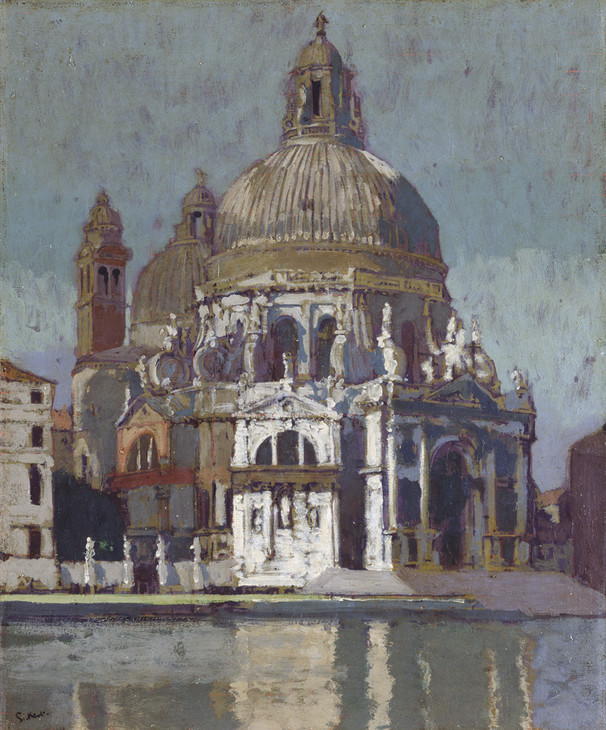
Walter Richard Sickert 1860–1942
Santa Maria della Salute, Venice c.1901
Oil paint on canvas
560 x 460 mm
Royal Academy of Arts, London
© Estate of Walter R. Sickert / DACS
Photo © Royal Academy of Arts, London; Photographer: John Hammond
Fig.1
Walter Richard Sickert
Santa Maria della Salute, Venice c.1901
Royal Academy of Arts, London
© Estate of Walter R. Sickert / DACS
Photo © Royal Academy of Arts, London; Photographer: John Hammond
Sickert made two versions of this oil. One of them was exhibited in Paris at Bernheim’s in 1907, but it is not possible to distinguish which. The other painting was first owned by Lord Croft, and is now entitled The Steps of Santa Maria della Salute c.1901 (private collection).2 There are a number of differences between the two works. The Tate picture has a shallower foreground than The Steps of Santa Maria della Salute, and is more silvery and grey in palette. The other version has the same figures on the steps, but the one on the left is painted in red to give a prominent accent to the composition. Both works are based on a charcoal and brown wash drawing, exhibited as Salute at the Carfax Gallery in May 1912.3
The first recorded owner of the Tate picture is the opera singer Blanche Marchesi (1863–1940). Born in France, she pursued her career in London from 1896 for much of her life. It is possible that Sickert knew her, and she certainly moved in artistic circles, visiting for instance the painter Paul Albert Besnard (1849–1934) in his Paris studio.4
Robert Upstone
May 2009
Notes
Reproduced ibid., no.169.1, and Modern British & Irish Paintings, Drawings and Sculpture, Sotheby’s, London, 28 September 1994 (63).
Related biographies
Related catalogue entries
How to cite
Robert Upstone, ‘Venice: La Salute c.1901 by Walter Richard Sickert’, catalogue entry, May 2009, in Helena Bonett, Ysanne Holt, Jennifer Mundy (eds.), The Camden Town Group in Context, Tate Research Publication, May 2012, https://www



